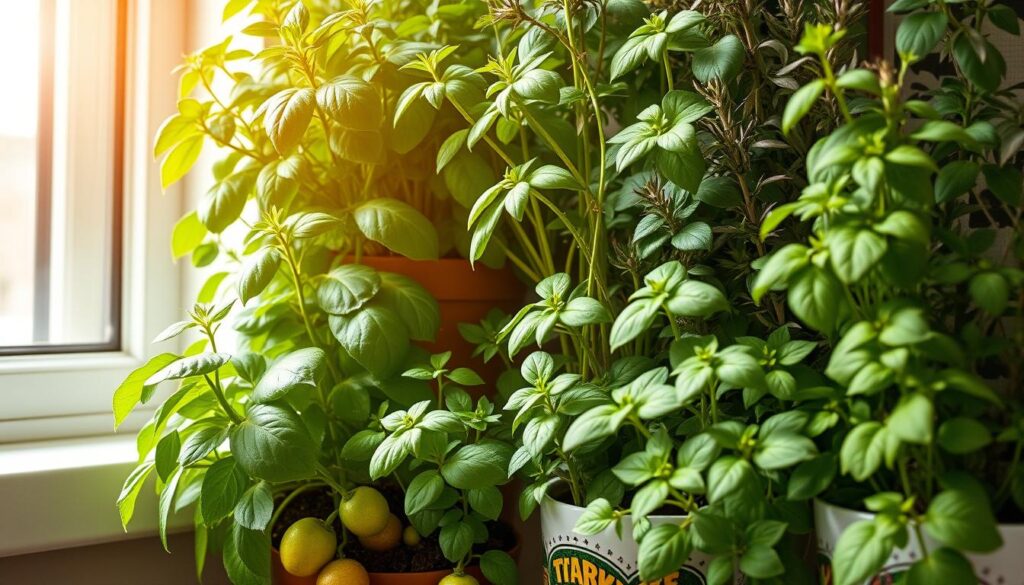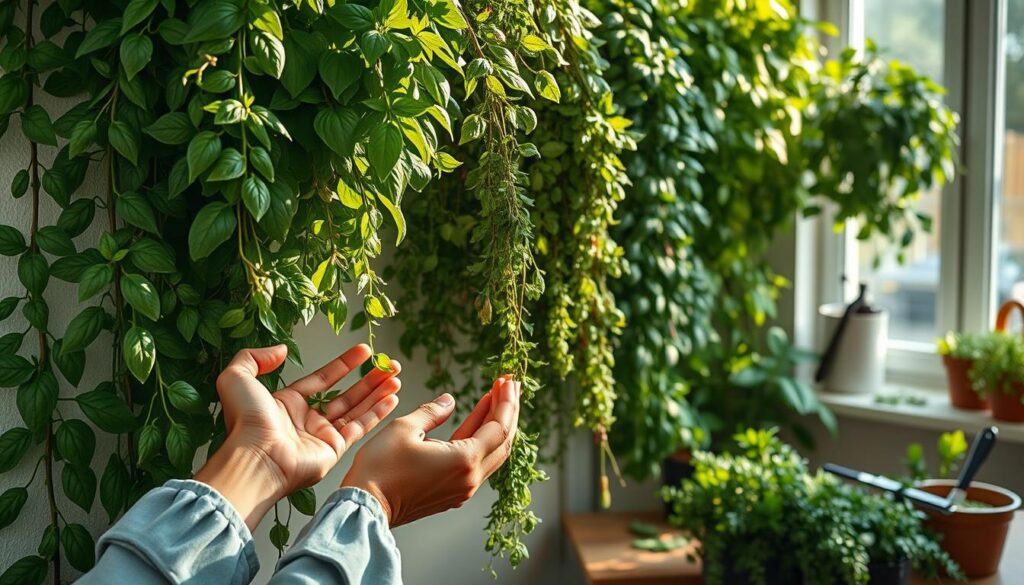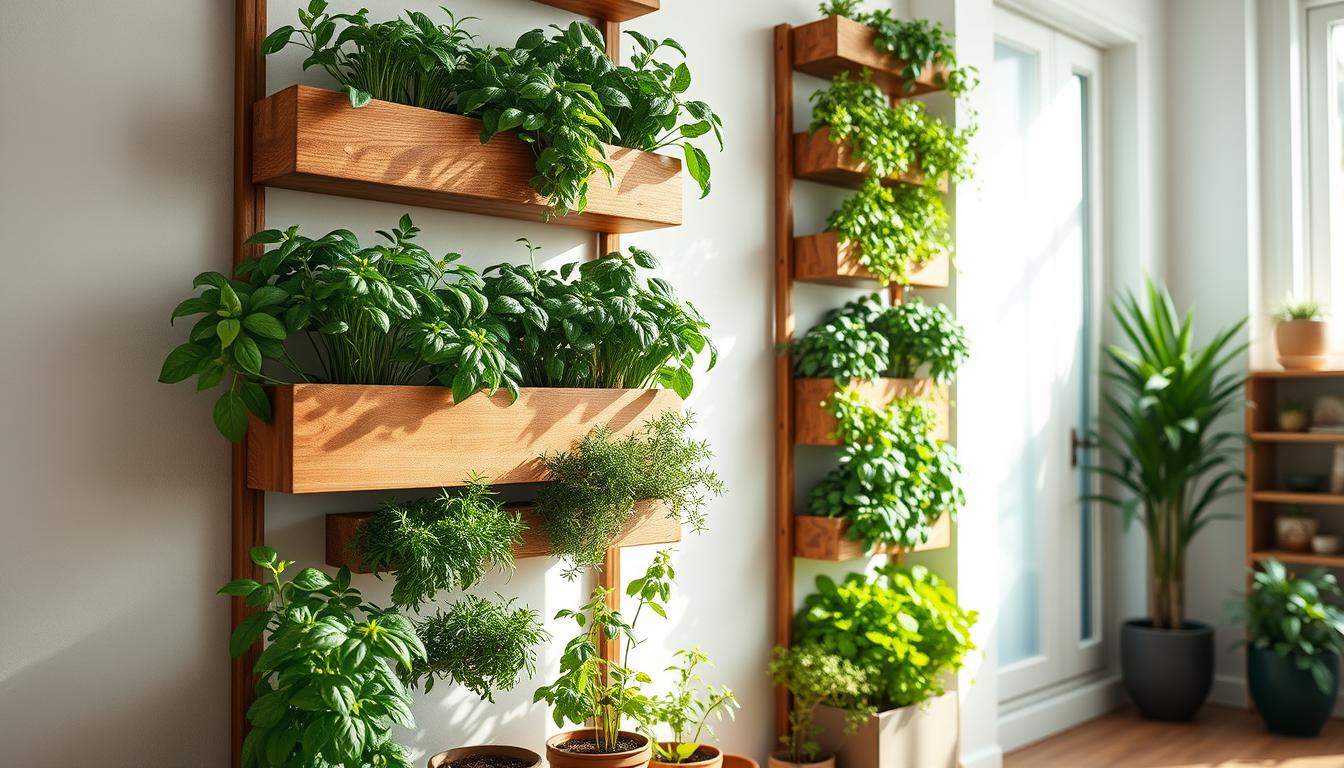Did you know you can grow a thriving indoor herb garden in just 20 square feet? This fact shows how powerful vertical gardening is. It’s changing how people grow fresh herbs and veggies, even in tiny spaces. If you have a small kitchen, a small apartment, or want fresh herbs easily, this guide is for you. It will help you make a vertical indoor herb garden that suits your space and needs.
Key Takeaways
- Maximize your limited indoor space with a vertical herb garden
- Discover the benefits of growing herbs indoors, from improved flavor to year-round availability
- Learn how to select the right herbs and plan the perfect layout for your vertical garden
- Understand the essential materials and tools needed to build a sturdy, functional structure
- Receive step-by-step instructions for planting, caring for, and harvesting your vertical herb garden
Introduction to Vertical Indoor Herb Gardens
More people are now growing their own indoor herb gardens. These gardens are a great way to save space and always have fresh herbs at home. They let city folks and home cooks enjoy fresh herbs all year.
Benefits of Growing Herbs Indoors
There are many good things about growing herbs indoors. Here are a few:
- Always have fresh, tasty herbs for your cooking
- Less work than outdoor gardens since you control the environment
- Enjoy the smell and health benefits of herbs all year
Choosing the Right Herbs for Your Indoor Garden
When picking herbs for your indoor garden, think about how much water and sunlight they need, and how big they’ll get. Some top herbs for indoor growing are:
- Basil: Loves bright, indirect light and good drainage.
- Mint: Does well in many light conditions and soils.
- Rosemary: Needs lots of sunlight and drains well.
- Thyme: Likes a sunny spot and soil that’s not too wet.
- Chives: Does great indoors and makes your food taste better.
Picking the right herbs for your indoor garden helps you create a beautiful and useful space. It adds to your kitchen and home’s look and taste.
Planning Your Vertical Indoor Herb Garden
Creating a successful vertical indoor herb garden needs careful planning. Start by picking the best spot for your herb garden. Look for a place in your kitchen or home that gets a lot of sunlight. This way, your herbs will grow well. Measure the space to figure out the size and layout of your garden, making sure it fits well with your decor.
Selecting the Ideal Location
When picking a spot for your indoor herbs, think about how easy it is to get to, how much light it gets, and how people move through the area. Choose a spot close to where you cook, so you can easily grab fresh herbs. Make sure it gets at least 6 hours of direct sunlight a day. Or, use grow lights if there’s not enough natural light.
Determining the Size and Layout
After finding the perfect spot, plan the size and layout of your vertical indoor herb garden. Measure the wall or shelf space you have and figure out how many shelves or tiers will fit. Think about how far apart shelves and plants should be, and how easy they are to reach. This will help you make the most of your space and keep your garden looking good.
| Factors to Consider | Recommendations |
|---|---|
| Shelf Spacing | 12-18 inches between shelves for optimal plant growth |
| Plant Spacing | 6-12 inches between individual herb plants |
| Accessibility | Place shelves at a height that allows easy reach and maintenance |
By planning your vertical indoor herb garden well, you’ll have a beautiful and useful space. It will give you a lot of fresh herbs all year.
Building Your Vertical Indoor Herb Garden Structure
Building a strong and good-looking vertical planter for your indoor herb garden is a fun DIY project. Use materials like cedar, tongue-and-groove boards, and galvanized hardware. This way, you can make a building vertical indoor herb garden that looks great and is useful. It also adds a rustic charm to your home.
When making your DIY indoor herb wall garden, think about adding removable shelves. This lets you change the growing spaces for different herbs. It also helps you use your vertical space well. The design can change as your herb garden grows and your needs do too.
| Material | Quantity | Purpose |
|---|---|---|
| Cedar Boards (1x6x8 feet) | 4 | Construct the main frame and shelves |
| Galvanized Screws | 1 box | Secure the boards and hardware |
| Galvanized L-Brackets | 8 | Support the removable shelves |
| Wood Glue | 1 bottle | Reinforce the joint connections |
Choosing the right materials and following a step-by-step guide, you can make a vertical indoor herb garden. It will look great and be a smart way to grow your favorite herbs at home.
“Gardening is the art of growing plants, which brings joy and beauty to one’s life and allows one to play a part in the miracle of nature.”
Vertical indoor herb garden guide
To make a thriving vertical indoor herb garden, you need the right materials and tools. Having these items ready makes putting it together easy and helps you grow herbs at home.
Essential Materials and Tools
For a vertical indoor herb garden, you’ll need:
- Wooden boards of varying sizes
- Deck screws
- A miter saw or circular saw for precise cutting
- A power drill or driver
- Clamps to hold the structure in place during assembly
These items help you build a strong, adjustable planter for your herbs.
Step-by-Step Instructions for Assembly
It’s important to follow a step-by-step guide for a DIY indoor herb garden. Start by measuring and cutting the wooden boards to fit your design. Use deck screws and clamps to put the frames together, making sure it’s stable. Then, add shelves or tiers to use more space vertically. With the right tools and materials, you can make a lovely and useful garden in your home.
“Growing herbs vertically is a game-changer for small-space gardeners. It’s amazing how much you can fit into a compact footprint.”
| Materials | Tools |
|---|---|
| Wooden boards | Miter saw |
| Deck screws | Power drill/driver |
| Potting soil | Clamps |
Planting and Caring for Your Vertical Herb Garden
Starting your vertical indoor herb garden is thrilling. It’s key to pick the best soil and containers. Also, learn how to water and fertilize them right.
Choosing the Right Soil and Containers
For planting your vertical indoor herb garden, choose top-notch potting soil made for herbs. This soil drains well and has lots of nutrients, perfect for your herbs. Use containers with good drainage like terracotta or glazed ceramic pots to avoid waterlogging and root rot.
Proper Watering and Fertilizing Techniques
Keeping your vertical indoor herb garden healthy means watering and fertilizing it right. Water when the top inch of soil feels dry. Don’t overwater. Use a fertilizer for herbs every two to three weeks during the growing season.
By planting vertical indoor herb garden well, picking the right soil and containers for indoor herbs, and watering and fertilizing correctly, you’ll have a thriving garden. This garden will give you fresh, tasty herbs all year.
Maximizing Space in Your Vertical Garden
Vertical gardening is a great way to grow a vibrant indoor herb garden. It lets you use your space wisely. You can grow many aromatic herbs in a small area, making even tiny spaces into a flavorful oasis.
Companion Planting for Herbs
Companion planting is a smart way to make the most of your vertical garden. It means choosing which herbs to grow together for better results. This approach helps with pest control, increases yields, and makes flavors richer. Here are some good pairings:
- Basil and tomatoes: Basil keeps aphids away from tomatoes and makes them taste better.
- Rosemary and carrots: Rosemary’s scent keeps carrot flies away, protecting your carrots.
- Mint and cabbage: Mint’s oils keep cabbage worms away, giving you a healthier harvest.
By choosing the right herbs to grow together, you use your space well. You get a garden that’s full of flavor and healthy herbs.

Vertical gardening and companion planting let you create a lush, efficient indoor herb garden. This garden will make your food taste amazing and fill your home with fresh scents.
Troubleshooting Common Issues
Keeping a vertical indoor herb garden healthy takes careful attention and quick problem-solving skills. Even with great care, your plants might face pests or diseases. But don’t worry! Knowing how to spot and fix these problems will help keep your herbs in top shape. This ensures you get a lot of fresh herbs for your kitchen.
Identifying and Treating Plant Pests and Diseases
Pests and diseases are common problems in indoor herb gardens. Watch your plants for signs like discolored leaves, wilting, or bugs. Aphids, spider mites, and thrips are pests that might bother your plants. Fungal diseases like powdery mildew or root rot can also harm your herbs.
- Look closely at your plants to see what’s wrong.
- Use natural ways to control pests, like introducing helpful insects or organic sprays.
- Keep your plants healthy by ensuring good air flow and the right amount of water.
- Check your plants often and fix problems quickly to stop them from getting worse.
By being alert and acting fast to fix troubleshooting vertical indoor herb garden or identifying and treating indoor herb pests and diseases, your garden will flourish. You’ll keep getting fresh, tasty herbs.
The secret to success in a vertical indoor herb garden is not just the plants themselves, but the ability to troubleshoot and address any issues that arise.
Harvesting and Using Your Fresh Herbs
The true joy of growing a vertical indoor herb garden is harvesting and enjoying the fresh herbs you’ve grown. Learn the best ways to harvest your herbs for ongoing growth and lots of herbs. Discover tasty ways to use your herbs in meals, drinks, and other dishes.
Harvesting Your Vertical Indoor Herb Garden
Harvesting your herbs at the right time is crucial for the best flavor and quality. Cut the leaves or stems in the morning, after the dew dries, but before it gets too hot. This keeps the herbs’ essential oils, which give them their unique smells and tastes.
Use sharp, clean scissors or pruners for clean cuts. Don’t take more than one-third of the plant at a time to keep it healthy.
- Snip leaves or stems in the morning for best flavor
- Use clean, sharp scissors or pruners for clean cuts
- Harvest no more than one-third of the plant at a time
Culinary Uses for Your Homegrown Herbs
There are endless ways to use your fresh, harvested vertical indoor herb garden herbs in cooking. Add basil to homemade pesto, rosemary to roasted veggies, or mint to iced tea. Try different flavors to make your meals and drinks taste better.
| Herb | Culinary Uses |
|---|---|
| Basil | Pesto, pasta dishes, tomato-based sauces |
| Rosemary | Roasted meats and vegetables, bread, cocktails |
| Mint | Teas, lemonades, salads, desserts |
Mastering harvesting vertical indoor herb garden and using fresh herbs from indoor garden in your cooking opens up a world of flavors. Enjoy the fruits of your labor in your kitchen.

Conclusion
Now you know how to design, build, and keep a thriving vertical indoor herb garden. Growing your own fresh herbs brings joy and many benefits to your kitchen and life. It makes your cooking taste better and keeps your home air clean.
Begin your vertical indoor herb garden today. It will make your cooking more flavorful. This journey connects you closer to nature. Enjoy watching your herbs grow and using them in your favorite meals.
Your journey with a vertical indoor herb garden is just starting. As you care for and grow your garden, you’ll see how fresh herbs can improve your life. Start this journey and explore new flavors in your cooking, all from your home.
FAQ
What are the benefits of growing a vertical indoor herb garden?
How do I choose the right herbs for my indoor garden?
Where should I locate my vertical indoor herb garden?
What materials and tools do I need to build my vertical indoor herb garden?
How do I plant and care for my vertical indoor herb garden?
How can I maximize the productivity of my vertical indoor herb garden?
How do I troubleshoot common issues with my vertical indoor herb garden?
How do I harvest and use the herbs from my vertical indoor garden?
Source Links
- How to Grow Lots of Herbs in a Small Space • Gardenary – https://www.gardenary.com/blog/how-to-grow-herbs-in-a-small-space
- How to Build a Vertical Herb (or Lettuce!) Planter – https://bonnieplants.com/blogs/diy-garden-projects/how-to-build-a-vertical-herb-planter
- How to Make an Easy Indoor Herb Wall Garden | Fall For DIY – https://fallfordiy.com/blog/2020/05/19/how-to-make-an-easy-indoor-herb-wall-garden/





Pingback: Essential Tools and Techniques for Successful Herb Propagation